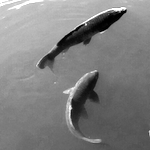The propelling fan of the waterstrider Rhagovelia, an evolutionary innovation, enhances the manoeuvrability on fast running water, an energy demanding and turbulent environment, mostly unexploited by others semiaquatic insects. This fan attached to the insect midleg, is a porous structure consisting of 20 lamellate branches. It opens into the water bulk right before the propulsion phase. The study of this evolutionary innovation offers a unique model to understand the tenuous link between the appearance of morphological innovation and adaptation to new ecological environments. Our aim is to determine how the morphology of the fan contributes to the locomotion performance.
We first characterized the kinematics of the fan during the propulsion phase and determined the structural and morphological features of the fan. In a second time, we produced a dynamically scaled mechanical model that replicates the movement of the fan. We measured the flow velocity field around the fan and determined the magnitude of forces acting on it. Finally, we used computations to resolve the flow around a numerical replicate of the fan. The computations, once validated by their comparison with experimental results using similitude principles, allowed us to determine the nature of resistive forces.
A large part of the fan resistive force is due to viscous shear stress like it is the case for bristled wings of small flying insects. The lamellate fan functions as a leaky paddle with over 90 % porosity, while producing between 80 and 100 % of the hydrodynamic drag force of an equivalent membrane oar. The viscous shear layers appearing in the gap between the lamellate branches reduce the leakage, forming a virtual fluid barrier. Eventually, we estimate that the porous lamellate structure maximizes the fan drag coefficient. The Rhagovelia fan achieves a structural optimality, enabling the displacement of large amounts of water with a minimum of material. This simple yet sophisticated architecture certainly confers to this small insect a decisive advantage to colonize turbulent fast running water environments.

 PDF version
PDF version
